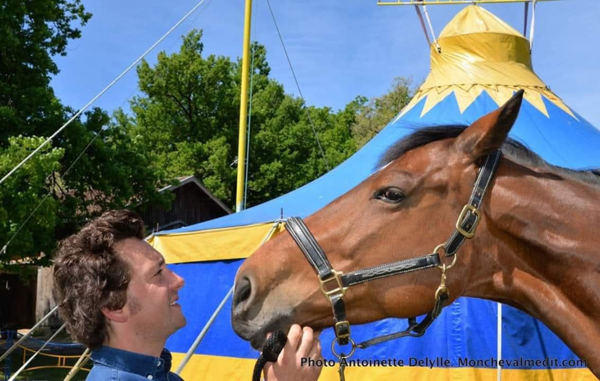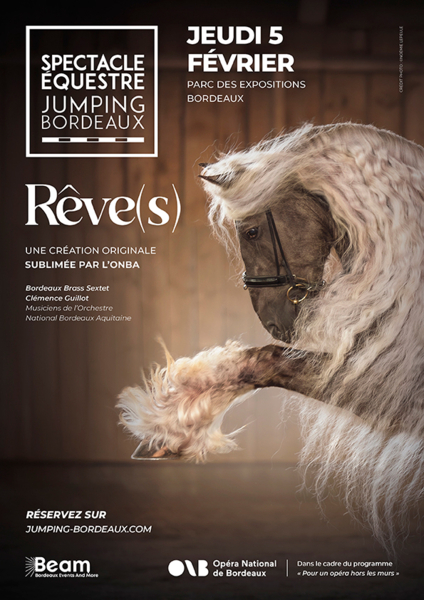Behind the scenes of Rêve(s) with its creator, Sébastien Capelli
On the occasion of the Jumping International de Bordeaux, we met with Sébastien Capelli, the director of the show Rêve(s). A professional rider, producer, and artist, he brings a unique perspective to the horse and to the art of portraying it on stage. In this interview, he reflects on his unconventional background, his deep connection with Bordeaux, and the creation of a show blending poetry, music, and equestrian sensitivity.
To begin, could you introduce yourself and tell us a few words about your background and artistic universe?
I left school at 15 to work with horses. This choice led to memorable encounters, including one with Jean Rochefort. At that age, I didn’t grasp its significance, but that crossing between the equestrian world and the artistic world already felt like a sign of destiny. I went on to pursue a career as a professional show jumping rider before moving toward production and events management. A pivotal moment was my meeting with Amandine Tirebois, who introduced me to equestrian performance and opened for me a more sensitive, inward, artistic relationship with the horse.
Over the years, I have organized numerous shows—both equestrian and non-equestrian—and taken part in film shoots as well as projects involving musicians. These experiences broadened my perspective, shaped my way of designing a show, and strengthened my desire to explore different forms of storytelling.
I also built a very special relationship with Bordeaux. We produced shows in the heart of the city, notably on Place Saint-Michel, because it mattered to me to bring live performance to working-class neighborhoods. My relationship with the Jumping International de Bordeaux is long-standing and multifaceted: as a child, I took part in a horse-ball demonstration in 1996; later, I competed in partner events as a rider; I handled the production of ring-side entertainment; I attended many editions as a spectator; and I even provided occasional support on a stand during one edition. I have truly experienced it from every angle.
How did your collaboration with the Jumping International de Bordeaux come about?
It naturally stems from this long and multifaceted connection with the event. For me, the Jumping is a major international event deeply rooted in the region. Having discovered it as a child, a rider, a spectator, and a producer, the idea of creating a show there naturally emerged as the next step—driven by the desire to bring something personal, artistic, and surprising.
Can you tell us how the show Rêve(s) was born?
Rêve(s) was born from a combination of elements that came together organically: my attachment to Bordeaux, my journey with horses, and the wish to present a project that truly reflects who I am. Reading the book Monsieur Cagole by Carole Rouland then added a more intimate layer. This text moved me deeply and opened the space in which the show began to take shape. Carole Rouland even wrote a few lines specifically for the scene featuring my daughter, who will open and close the performance.
I also wanted Rêve(s) to align with the artistic standards of the Jumping International de Bordeaux. A formation from the Opéra National de Bordeaux will perform, including my partner, a violist, who is an integral part of this creation. The presence of equestrian artists whom I profoundly admire—and with whom I had a strong desire to collaborate—also helps shape the identity and sensitivity of the show.
How did you imagine the staging? What artistic and scenographic elements lie at the heart of the creation?
The staging of Rêve(s) draws from diverse inspirations: James Thierrée, Rachid Taha, Charlie Chaplin, Gilles Audejean, certain circus aesthetics, and classical music performed by musicians from the Opéra National de Bordeaux. Cinema also plays an important role, particularly the worlds of Jean-Pierre Jeunet and Cédric Klapisch. I’ve always regretted not having known the artistic movement of the 1980s “Caravane de Quartier,” whose popular creative energy would have deeply inspired me.
Despite the diversity of these influences, the guiding principle remains simple: the staging is designed to place the horse at the center. The light, the space, and the rhythm are crafted to reveal its presence, its fragility, its power, and the relationship it builds with the artists.
Finally, I wanted to surprise the audience, to take them beyond the purely equestrian dimension, with unexpected moments where music, imagery, movement, and dramaturgy open new sensory doors.
The Jumping de Bordeaux sits at the crossroads of sport, passion, and art. How did you integrate these dimensions?
Knowing the Jumping from so many different angles allowed me to understand its true identity. I also once produced an equestrian show on Place Saint-Michel, in the heart of a working-class district of Bordeaux—a powerful moment for me. It reminded me of the importance of offering art that is accessible, alive, and rooted in the city.
With Rêve(s), I wanted to revive that spirit: to accompany the sporting dimension of the Jumping while offering a genuine artistic pause—sincere, sensitive, and deeply anchored in the local territory.
In your opinion, what does the horse represent for humans? And what does it still have to teach us?
As a child, I experienced a lot of worry, anxiety, then agoraphobia, and eventually left school. During those years, horses were an essential refuge. Their constancy, their honesty, their way of existing without judgment played a crucial role in restoring my balance. That is why the horse holds such a central place in my life. It offers a form of truth, patience, and inner alignment that I’ve never found anywhere else.
In all the shows I create, there is this desire to pay tribute to them—to what they gave me, to what they continue to give to those who truly connect with them, and to how they reveal the most sincere part of each person. More broadly, I believe the horse remains a guide for humankind. It brings us back to what truly matters: coherence, presence, and respect for all living beings.



